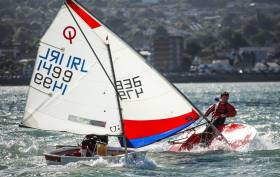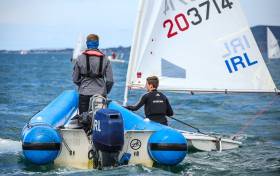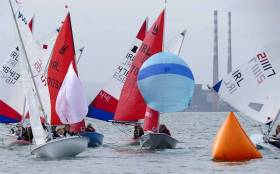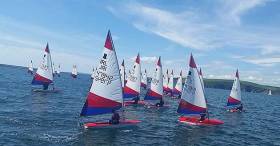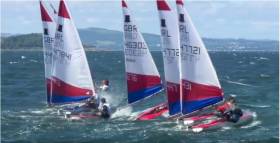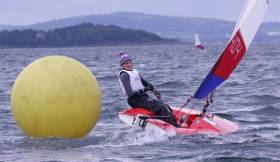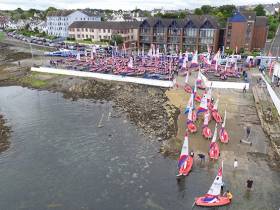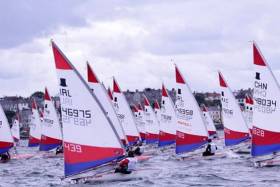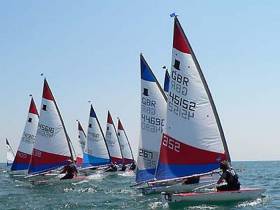Displaying items by tag: Topper
ISA Youth Seminar Dates 'Postponed' Til 2017
The first of the new ISA Junior Sailing Performance Seminars was postponed last month and will now take place at a date to be announced in 2017. As Afloat.ie reported in September the ISA announced that the seminars were replacing the ISA Optimist Squads and ISA Topper Squad which have traditionally run from October to March.
The ISA said at the launch of the new initiative: 'Given our limited resources we feel this approach will give a better return on investment while at the same time giving the pathway much more visibility across a wider base'.
Scheduled for the Irish Institute of Sport last weekend the first of three winter seminars was aimed at 'junior sailors of all classes born between 2001 and 2004 who are passionate about their sailing and want to learn important skills which will help with their overall development in the sport'.
No reason has been given as to why the October date was postponed by the ISA on its website here.
The seminars aim to educate sailors about the ISA pathway and help sailors understand their options and choices when graduating through the different sailing classes.
The opening seminar will focus on education of the sailor in areas outside the technical skills of sailing their chosen class. Topics covered at the seminar will include –
The cost of the first weekend seminar is €50 per sailor.
Show of Youth Sailing Strength for Royal St. George As Big Breeze Forecast for Junior All–Irelands
Tomorrow's All Ireland Junior sailing championships looks like it will get off to a wet and windy start for the 16–nominated junior sailing stars drawn from seven yacht clubs from around the country.
The Under–18 championships is scheduled to race over two days in West Cork's own TR3.6 two handed dinghies but the weather forecast for the Schull venue shows winds topping 40–knots for Saturday and the same again on Sunday.
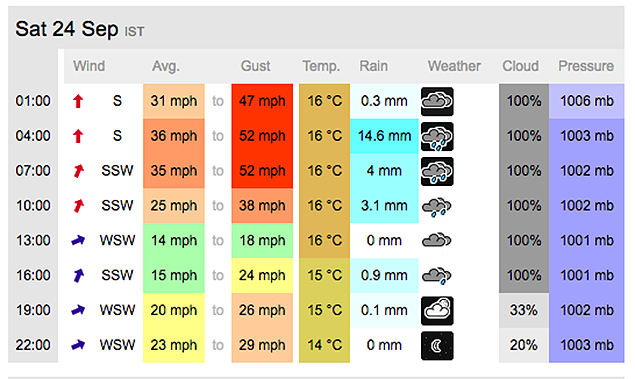 XC weather forecaster shows big winds in Schull, West Cork tomorrow
XC weather forecaster shows big winds in Schull, West Cork tomorrow
In a show of strength for Dublin's Royal St. George Yacht Club more than a third of the participants are drawn from the Dun Laoghaire club. RStGYC juniors are representing the RS200 (Toby Hudson Fowler), the RS Feva (Henry Start), Laser 4.7 (Peter Fagan), Optimist (Tom Higgins), Topper (Jack Fahy) and Kate Lyttle from the 420 class.
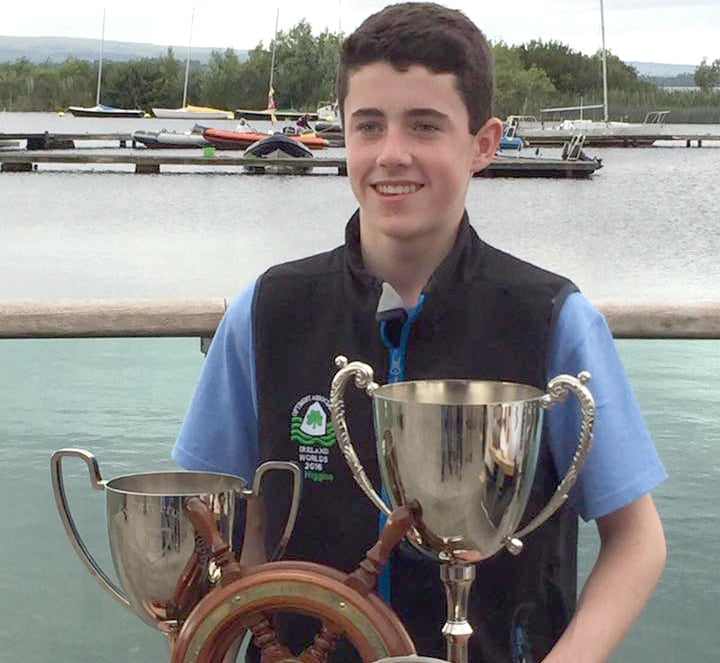 Multi–champion in the Optimist class, Tom Higgins from the Royal St. George, is nominated for this weekend's All Ireland Juniors in Schull
Multi–champion in the Optimist class, Tom Higgins from the Royal St. George, is nominated for this weekend's All Ireland Juniors in Schull
Royal Cork Yacht Club is the next biggest club on the water in Schull with four sailors involved. 29er skipper Harry Durcan and twin Johnny representing 29er and Laser Radials respectively. Harry Twomey represents the Optimist class and Sophie Crosby sails for the Toppers.
The National Yacht Club's Clare Gorman represents the Laser 4.7 and will defend the girls title and the NYC's Leah Rickard sails for the Optimists.
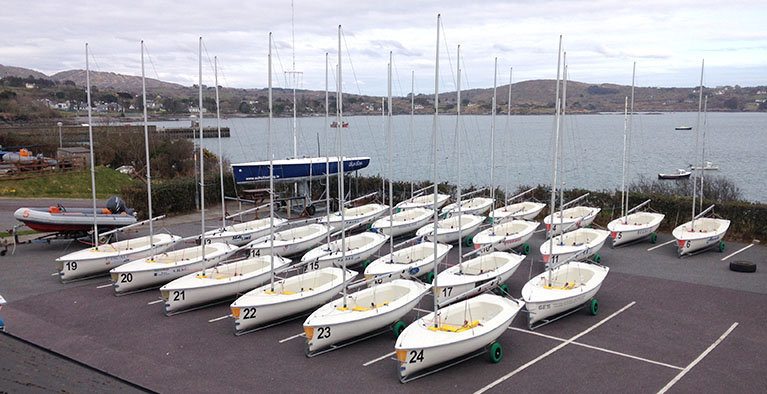 Schull's own TR3.6 dinghies ready for the junior all Ireland sailors. Photo: Fastnet Marine
Schull's own TR3.6 dinghies ready for the junior all Ireland sailors. Photo: Fastnet Marine
The West coast is represented by three clubs.Topaz sailors Adam Byrne and Dylan Reidy representing Dingle SC and Foynes YC respectively and Sligo Yacht Club sends Mirror ace Sarah White.
The 420 class is represented by Geoff Power of Waterford Harbour Sailing Club.
Full nominee list below
| Class | Name | Surname | Club |
|---|---|---|---|
| RS200 Junior | Toby | Hudson Fowler | Royal StGeorge YC |
| RS Feva | Henry | Start | Royal St George YC |
| Mirror | Sarah | White | Sligo YC |
| Laser 4.7 | Clare | Gorman | NYC |
| Laser 4.7 | Peter | Fagan | Royal St George YC |
| Laser Radial | Johnny | Durcan | RCYC/NYC |
| Topaz | Adam | Byrne | Dingle SC |
| Topaz | Dylan | Reidy | Foynes YC |
| Topper | Jack | Fahy | RSTGYC |
| Topper | Sophie | Crosby | RCYC |
| 420 | Geoff | Power | WHSC |
| 420 | Kate | Lyttle | RStGYC |
| OPTIMIST | Tom | Higgins | RSGYC |
| OPTIMIST | Harry | Twomey | RCYC&CHSC |
| OPTIMIST | Leah | Rickard | NYC |
| 29er | Harry | Durcan | RCYC |
New 'Performance Pathway Seminar' Series is Launched By ISA
In an exciting new initiative for youth sailors, the Irish Sailing Association has announced provisional details on a series of Performance Pathway Seminars.
The seminars are replacing the ISA Optimist Squads and ISA Topper Squad which have traditionally run from October to March. The change of tack does not affect summer activities which start after the ISA Pathway Nationals.
The seminars are primarily targeted at junior sailors from the Topper and Optimist classes and their coaches. There will also be sessions available to parents of sailors. Other applications may be considered.
There will be a minimum of three seminars over the winter and the topics will include but not be limited to Fitness, Psychology, Programme Design, Nutrition, Boat Transition, Olympic pathways.
The very clear switch to focussing on the education of young athletes means ISA Performance can widen the scope of how many athletes and coaches it can engage with over the course of the year. The ISA says 'the Pathway has often been criticised for not being inclusive enough so this initiative will tackle that concern head on'.
The ISA say 'Given our limited resources we feel this approach will give a better return on investment while at the same time giving the pathway much more visibility across a wider base. ISA Performance will NOT be running the ISA Optimist Squad or the ISA Topper squad this winter'.
There is additional investment going into the ISA coaching programme and it is hoped this programme will help facilitate the clubs and classes take on the role of training over the winter period.
As always the ISA Pathway Nationals will be the key event in the domestic programme. The ISA plan to invest more into the event and ISA Performance will continue to use this event to determine squads for the summer events.
Provisional Dates
OCT 29th & 30th
DEC TBC
JAN TBC
More Details and Application Process will be posted October 7th. In the meantime save the dates. It is envisaged we would have between 20 and 30 places per class association
Munster Topper Championship Won By Kinsale Yacht Club Sailor
Kinsale Yacht Club hosted the Munster Topper Championships for the first time this weekend. A fleet of 47 boats took to the water on Saturday morning. A strong easterly breeze and heavy seas provided challenging conditions for the sailors and for some this was their first event, but all sailors completed all three races on day one. Download results below.
Michael Carroll, KYC, took line honours in the first race with Micheal O’Suilleabhain, KYC, 2nd and Hannah Liddle, EABC, 3rd. With the fleet pushing hard on the line for the second race a General Recall was inevitable and it restarted under the U Flat. A gear failure early in the 2nd race put Michael Carroll out. Micheal O’Suilleabhain sailed a great race and took 1st Robert Keal, RCYC, 2nd, Dan McGaughey, DSC, 3rd and Sophie Crosbie, RCYC 4th. Race 3 saw Micheal O’Suilleabhain take line honours again , Robert Keal 2nd , Michael Carroll 3rd and Sophie Crosbie 4th.
Sunday the wind was northerly and the seas were a lot kinder to the sailors. Race 4 got under way and from the off it was evident that Micheal O’Suilleabhain and Michael Carroll were battling it out at the head of the fleet. Michael Carroll took line honours with Micheal O’Suilleabhain hot on his heels. Mia Murphy, RCYC, took 3rd with Sophie Crosbie in 4th. Race 5 saw Michael Carroll take the line with Jack O’Sullivan, KYC/RCYC, taking 2nd place, Micheal O’Suilleabhain 3rd and Sophie Crosbie 4th.
Going into the final race it was all to play for as Michael Carroll and Micheal O’Suilleabhain were tied on points. A wind shift saw some sailors take advantage of the left side of the upwind leg which paid off and Tom Higgins, RStGYC, took line honours with Hannah Liddle 2nd and Micheal O’Suilleabhain 3rd. This was enough to secure him the trophy. Michael Carroll was 2nd overall and Sophie Crosbie was 3rd overall.
The 4.2 Fleet saw consistent sailing from it’s competitors with Lewis Thompson, DSC, scoring six 1st Places to take the title, Emma Lynch, WHBTC, came 2nd with Lochlan Briggs, EDYC in 3rd.
Topper Worlds At Ballyholme Yacht Club Video Review
Reliving last week's dramatic conclusion to the Topper World Championships in Ballyholme Yacht Club in Northern Ireland with a ten–minute epic video by Digby Fox. It was the second biggest world's turnout in the history of the event. More details in our review here and watch the video below.
Irish Topper Squad Slip in Final Day of World Rankings
Things were looking good for the Irish squad going into the final day of the Topper Worlds at Ballyholme YC, with Jack Fahey of Lough Derg and Royal St George the Thursday overnight front runner. In leading the Irish charge, he was cushioned ahead of Michael Carroll of Kinsale/Crosshaven in second and Sophie Crosbie of RCYC at third. But the points margins through Friday have been very tight, and the breezy pace of racing in the Gold Flight in the day’s sunshine has taken its toll.
Elliott Kuzyk of Parkstone YC on Poole Harbour in the south of England had been among the front runners in the early stages of the week. But he’d to carry a penalty from Race 4, while a third and a fifth in the opening races had seen his points total astray relative to the stellar early showings by the Irish trio and the top English challenger, Sam Cooper of Lancashire.
However, Kuzyk forcefully demonstrated he has what it takes when the chips are down, with an all-conquering showing in Friday’s stronger wind in the clearer fleet provided by the Gold Flight. Three firsts, a second, a fourth and a fifth saw him able to discard his other fifth and the penalty to move into the overall lead, while another south of England helm, Tim Hartnell from Lancing, moved into second overall with his concluding races scoring a first, three seconds and a third.
Early leader Sam Cooper also got back in the hunt, a second, two fourths and a seventh being enough to get him up to third and the Bronze Medal just ahead overall of Michael Carroll, who at fourth was best of the Irish. But Scotland’s Calum Bell managed to get between Carroll and Jack Fahy to slot into fifth, while Fahy was off form in the last four races, with a scoreline of 14th, 24th, 16th and 12th. But he still managed to be sixth overall while Sophie Crosbie of Royal Cork was seventh.
The Silver Flight brought reward for the large Chinese contingent, as it was won by Yubai Zhang, but there was a long lineup of British sailors thereafter, with Andrew Sturt second and Daniel Thompson third atop a continuous line of British success until 9th place, where Jonathan Sargent of Howth was first of the Irish.
The 4.2 division were kept ashore in Friday’s stronger winds, and the overnight lead of Thailand’s Max Yuang-Ngam is now the final result, with China’s Rabbit Su in second and Thailand’s Paton Mervielde third.
But although the final outcome of the main event may have been frustrating for the Irish squad after the high hopes of Thursday night, in the Ladies Division of the 5.3s the news was much better, as Sophie Crosbie’s 7th overall put her first, the National YC’s Ella Hemeryck at 11th overall was a clear second, and Jenna McCarlie of County Antrm YC (Whitehead) was third at 17th overall.
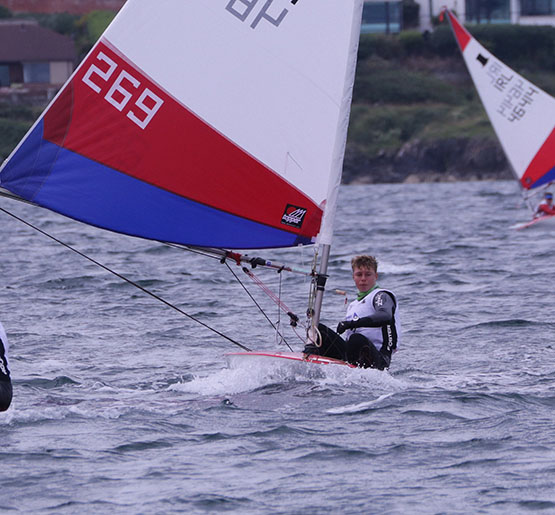 The new Topper World Champion, Elliot Kuzyk (GBR)
The new Topper World Champion, Elliot Kuzyk (GBR)
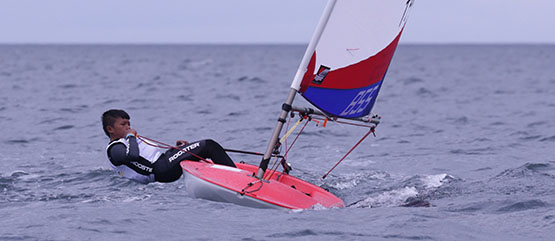
Overall results here
Lough Derg's Fahy Takes Lead in Topper Worlds
Jack Fahy of Lough Derg and Royal St George has taken the overall lead in the senior 5.2 Division at the Topper Worlds at Ballyholme, while Max Yuang-Ngam of Thailand continues at the head of the junior fleet in the 4.2 section.
Thursday’s racing, which has seen the 197 entrants sorted into Gold, Silver and Bronze fleets, was good for the large Irish representation, who maybe felt more at home as some rain and fog moved across the waters of Belfast Lough.
Whatever the reason, overnight leader Sam Cooper from Lancashire slipped down the rankings, and there was wholesale upward movement by Irish boats, with Fahy finishing the day’s racing in first in the Gold Fleet while Michael Carroll of Kinsale and RCYC made significant gains to move into second, with Sophie Crosbie of Royal Cork taking over third slot.
Thailand now lie first and third in the 4.2s, with Thai sailor Paton Mervielde moving into third, while Rabbit Sue continues to fly the flag for the large Chinese contingent in second overall.
Topper Worlds At Ballyholme Good For Ireland & Asia
The Topper Worlds 2016, in full swing at Ballyholme Yacht Club on Belfast Lough this week, have been showing that Ireland is well ranked in the current fleet. But the future could well be in Asia, as the younger sailors from Thailand and China have been setting the pace in the junior division.
In all, 197 boats are competing, and the 84-strong home division have been giving a good showing in very close racing at the top of the main section after three days racing the Topper 5.3. Just six points cover the top eight places, and while England’s Sam Cooper (West Lancashire YC) is currently leading with a scoreline of 2,1,1, 2, and discarding a third, Jack Fahy of Lough Derg & Royal St George is just one point astray on a score of 3,1,1, 2 and discarding a fourth.
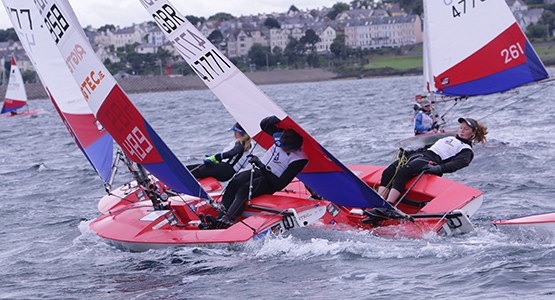
Scotland’s Harris Cartwright slips into the ranking in third, but then Sophie Crosbie of Royal Cork and Michael Carroll (RCYC/Kinsale YC) are fourth and fifth, with Michael O’Suilleabhain next of the Irish in eighth, only one point behind Carroll as three boats are tied on fifth.
It’s a different story in the Juniors racing the Topper 4.2, where Max Yang-Ngam of Thailand (Phuket YC) discards a second to leading by 9 points to the 19 points of second-placed Rabbit Su of China, while Britain’s Curtis McKay is third, but on 26 points. The large Chinese contingent (28 in all) are doing well in his section, while Ireland’s best is currently Hannah Dadey-Young (Ballyholme YC) at 10th overall, with Aoife McMahon (Howth) at 14th.
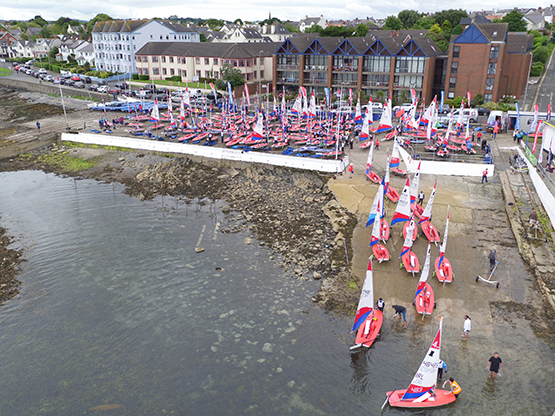 Gravity is on your side when you’re getting 197 Toppers afloat at Ballyholme – it’s when you’re getting a tired fleet back up again after racing that the teamwork really shows...
Gravity is on your side when you’re getting 197 Toppers afloat at Ballyholme – it’s when you’re getting a tired fleet back up again after racing that the teamwork really shows...
Topper Worlds Sets Sail At Ballyholme Yacht Club
The Opening Ceremony and Flag Parade of the Rooster International Topper Class World Championships 2016 was held at Ballyholme Yacht Club on Saturday. A total of 199 entrants will come in from all over the world, including China, Thailand and Australia, with Northern Ireland last hosting the event back in 2000 at Cushendall. There are 84 sailors from Ireland, 68 sailors from Great Britain and 32 sailors from China attending.
Topper Worlds 2016 At Ballyholme Yacht Club This Month
The 2016 Topper Worlds at Ballyholme from July 23rd will see a strong international fleet with a large contingent from China, but for the first time ever, the most numerous national contingent will be from Ireland. The World Championships will be held on the waters of Belfast Lough from the 23rd to the 29th of July 2016, hosted by Ballyholme Yacht Club in Bangor, County Down. It’s the first time that the Topper Worlds have been held in Northern Ireland in sixteen years – they were staged at Cushendall in County Antrim in 2000.
Bill Brassington, President of the International Topper Class Association, has stated: “The International Topper Class is extremely excited to be returning to Ireland for our 23rd World Championship in 2016. Ballyholme Yacht Club and the waters of Belfast Lough are set to provide exciting and competitive racing afloat and a friendly community ashore, which competitors and their supporters will greatly appreciate.”
The event comprises two World Championship series, and as the International Topper is a World Sailing recognised centreboard dinghy, the winners of these Championships are officially acknowledged as World Champions. The first World Championship will be made up competitors using the standard 5.3m2 sail, and has over 150 entrants.
The second World Championship is comprised of approximately 50 boats using the smaller 4.2m2 sails. The Intercontinental Cup will be presented to the top female sailor in the 5.3m2 fleet and an International Masters event will be held which is open to all male and female sailors over the age of 21.
There is a strong international element to the Rooster International Topper World Championships, with competitors from ten countries across four continents. China will send a team of 32 sailors to the Worlds, the largest entry from outside Europe, and the third largest country group overall in the Championships.
The second largest entry is from Great Britain, while for the first time ever, the largest entry is from Ireland with a total of 84 Irish sailors to date. Other countries that will be represented at the competition are Turkey, Macau, Japan, South Africa, Australia, Thailand and France.
It’s expected that by the time racing is under way, the event will have attracted over 200 sailors who, together with their coaches, family members and supporters, will bring over 700 visitors to Northern Ireland. These visitors may be interested in touring some of the local attractions such and taking in the natural beauty that Northern Ireland provides, as the area has much to offer within easy travelling time.
The light and durable design of the award winning International Topper makes it perfect for youth competitors. In fact, the Topper is an Olympic Youth Pathway class in both Great Britain and Ireland. The average age of competitors is therefore quite young but there will be sailors of all ages competing at this year’s Worlds, with the youngest competitor being 7 years old while the oldest is 61.
Over 48,000 Toppers have been built and sold worldwide and the boat is sailed in over 50 countries. The International Topper Class is delighted that many former Topper sailors have moved on to Olympic participation. In Great Britain, five former Topper sailors are competing in the Rio 2016 Olympics: Giles Scott, Alison Young, Nicola Groves, Dylan Fletcher and Alain Sign.
Representing Ireland at the Rio 2016 Olympics will be Ballyholme's former Topper sailors Ryan Seaton and Matt McGovern, along with Annalise Murphy and Finn Lynch, who won Silver in the Topper World Championships in 2011. Helena Lucas MBE will also be competing for Great Britain in the Paralympics.


























